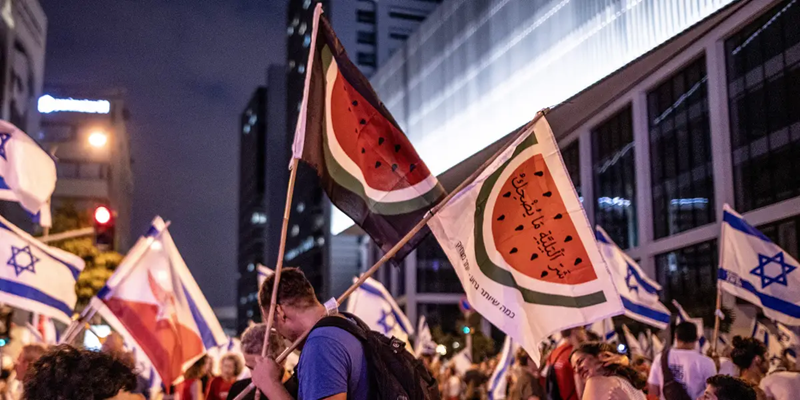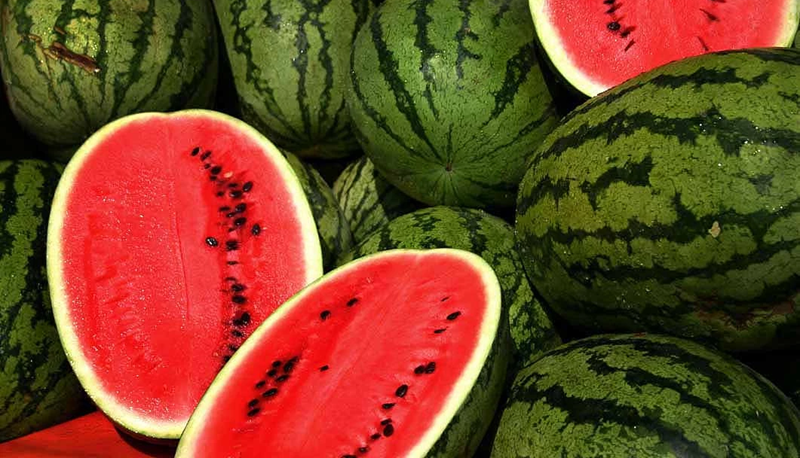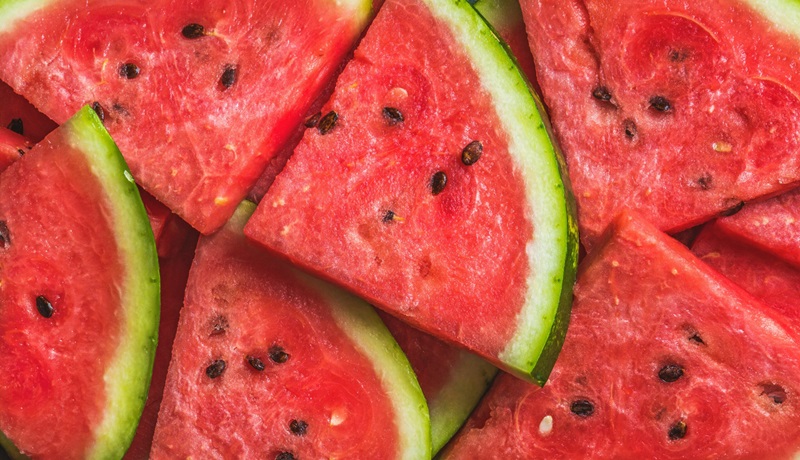Watermelons have become a powerful symbol of Palestinian resistance in recent years. The fruit’s significance stems from its association with Palestinian farmers and their struggle to maintain control over their land in the face of ongoing occupation. Watermelon farming has long been a key industry in Palestine, with the fruit serving as a staple crop for many Palestinian families.
However, in recent years, Israeli authorities have increasingly targeted Palestinian farmers, confiscating their land and destroying their crops in an effort to expand illegal settlements. In response to this aggression, watermelons have come to symbolize the resilience and determination of the Palestinian people to resist occupation and assert their right to self-determination.
The humble watermelon has become a potent symbol of Palestinian resistance for several reasons. First and foremost, watermelon farming is deeply rooted in Palestinian culture and history, making the fruit an inherently Palestinian symbol.
For generations, Palestinian farmers have cultivated watermelons as a source of sustenance and income, passing down their knowledge and expertise from one generation to the next. As such, the fruit has become a powerful symbol of Palestinian heritage and resilience in the face of adversity.
Secondly, watermelons have come to represent the Palestinian people’s connection to their land and their refusal to be uprooted from it. As Israeli authorities continue to confiscate Palestinian land and expand illegal settlements, watermelon farmers have become increasingly marginalized and endangered. By targeting watermelon farms, Israeli forces seek to undermine Palestinian livelihoods and erode their ties to the land. In response, Palestinian farmers have turned to watermelons as a means of asserting their presence and reclaiming their rights to their land.
Moreover, watermelons have also become a symbol of Palestinian resistance in the realm of international politics. As images of watermelon farmers facing off against Israeli soldiers circulate on social media and in the press, the fruit has become a potent symbol of Palestinian resilience and defiance.
By standing firm in the face of aggression and asserting their right to self-determination, Palestinian farmers have inspired solidarity and support from people around the world. In this way, watermelons have become a powerful tool for raising awareness about the plight of the Palestinian people and garnering international support for their struggle.
In conclusion, watermelons have become a powerful symbol of Palestinian resistance due to their deep roots in Palestinian culture and history, their representation of the Palestinian people’s connection to their land, and their ability to inspire solidarity and support on a global scale.
As Palestinian farmers continue to face aggression and oppression from Israeli authorities, watermelons serve as a potent reminder of the resilience and determination of the Palestinian people to resist occupation and assert their right to self-determination. Through their cultivation of watermelons, Palestinian farmers are reclaiming their land, their heritage, and their future, one fruit at a time.

A Fruit with a Message: The Historical Roots of Watermelon Symbolism of Palestinian Resistance
Watermelon has long been a symbol of Palestinian resistance and resilience. Its historical roots can be traced back to the early 20th century when Palestinian farmers began cultivating watermelon as a way to assert their connection to the land and resist the encroachment of Zionist settlers.
The fruit’s vibrant colors and refreshing taste came to represent the Palestinian people’s strength and perseverance in the face of adversity. During the Nakba of 1948, when hundreds of thousands of Palestinians were forced from their homes, watermelon became a powerful symbol of hope and defiance. It was a reminder of the rich agricultural traditions that had sustained Palestinian communities for generations.
In more recent years, watermelon has continued to hold significance in Palestinian culture, often featured in political artwork and used as a symbol of solidarity with the Palestinian cause. Its association with resistance has made it a target for censorship and repression by Israeli authorities, who view the fruit as a subversive symbol of Palestinian identity. Despite these challenges, watermelon remains a potent symbol of Palestinian resistance, a reminder of the enduring spirit of a people who refuse to be erased from their own land.
Beyond Refreshment: The Watermelon’s Evolution as a Symbol of Solidarity of Palestinian Resistance
The watermelon has evolved beyond being just a refreshing fruit to become a powerful symbol of solidarity for Palestinian resistance. Its journey from a simple fruit to a symbol of unity and defiance against oppression is a testament to the resilience and creativity of the Palestinian people.
The watermelon’s vibrant green skin and deep red flesh have come to represent the Palestinian flag, a symbol of national pride and identity. In addition, its seeds scattered throughout the fruit symbolize the scattered Palestinian population and their unwavering connection to their homeland. The act of sharing a watermelon has become a gesture of solidarity, a way for Palestinians to come together and show their support for each other in the face of adversity.
The watermelon’s association with resistance has grown stronger over time, as it has been used in protests and demonstrations to convey a message of strength and unity. By embracing the watermelon as a symbol of their struggle, Palestinians have found a way to express their resistance in a peaceful and inclusive manner.
As they continue to face challenges and obstacles in their quest for self-determination, the watermelon remains a powerful symbol of their resilience and determination to overcome adversity. In this way, the watermelon has transcended its humble origins to become a potent symbol of Palestinian resistance and solidarity.

Global Recognition: How Watermelons Became an Icon of Palestinian Identity
Watermelons have become an iconic symbol of Palestinian identity on the global stage. This humble fruit has captured the hearts of people around the world, representing resilience, perseverance, and the ability to thrive in challenging conditions.
The rich history of watermelon cultivation in Palestine dates back centuries, with farmers using traditional farming methods to grow this juicy and refreshing fruit in the arid climate of the region. The vibrant green and red colors of the watermelon have come to symbolize the Palestinian flag, creating a powerful visual representation of national pride and unity. Additionally, the sweet and succulent taste of watermelon is a beloved treat during hot summer months, bringing people together in joyful celebrations and gatherings.
The rise of social media and cultural exchange has further elevated the status of watermelons in Palestinian culture, with hashtags and viral videos showcasing the beauty and abundance of this beloved fruit. As Palestinians continue to assert their cultural identity and demand recognition on the global stage, the watermelon stands as a powerful symbol of resilience and strength.
Its popularity and widespread recognition serve as a reminder of the enduring spirit of the Palestinian people and their unwavering commitment to preserving their heritage and traditions. In a world where identity and belonging are constantly challenged, the watermelon remains a steadfast symbol of Palestinian pride and unity.
The Green, Red, and Black: Decoding the Colors of Palestinian Unity
The colors green, red, and black hold significant symbolism in Palestinian culture, representing unity and resilience in the face of adversity. The green represents the fertile land of Palestine, symbolizing hope and growth despite the challenges faced by the Palestinian people.
The red symbolizes the blood shed by Palestinians in their struggle for freedom and self-determination, serving as a reminder of the sacrifices made in the pursuit of justice. The black represents the Palestinian people’s steadfastness and determination to resist occupation and oppression, standing strong in the face of adversity.
Together, these colors serve as a powerful visual representation of Palestinian unity and solidarity, reminding the world of the ongoing struggle for Palestinian rights and justice. By understanding the meanings behind these colors, we can gain a deeper appreciation for the resilience and strength of the Palestinian people, as they continue to fight for their homeland and their rights.
In a landscape marked by conflict and division, the colors green, red, and black serve as a beacon of hope and unity for Palestinians around the world, inspiring them to continue their struggle for freedom and dignity.

A Colorful Defiance: The Visual Impact of Watermelons in Activism
Watermelons have become a powerful symbol of defiance and resistance in various forms of activism. The vibrant colors and unique patterns of watermelons serve as eye-catching visuals that draw attention to important social issues. From protests against environmental degradation to calls for racial justice, watermelons have been utilized in creative ways to make a statement.
The visual impact of watermelons in activism cannot be understated, as they not only serve as a symbol of unity and solidarity but also as a reminder of the urgent need for change. By incorporating watermelons into their protests and demonstrations, activists are able to spark conversations and raise awareness about pressing issues in a visually compelling way. Whether displayed as banners, painted on signs, or carried as props, watermelons have a way of capturing the attention of onlookers and leaving a lasting impression.
The use of watermelons in activism is a testament to the power of visual storytelling and the importance of creativity in advocacy efforts. By tapping into the symbolic power of this iconic fruit, activists are able to communicate complex messages in a simple and accessible way.
The colorful defiance of watermelons in activism serves as a powerful reminder that change is possible and that together, we can work towards a better and more just world. So next time you see a watermelon being used in a protest or demonstration, take a moment to reflect on the visual impact it has and the important message it represents.
